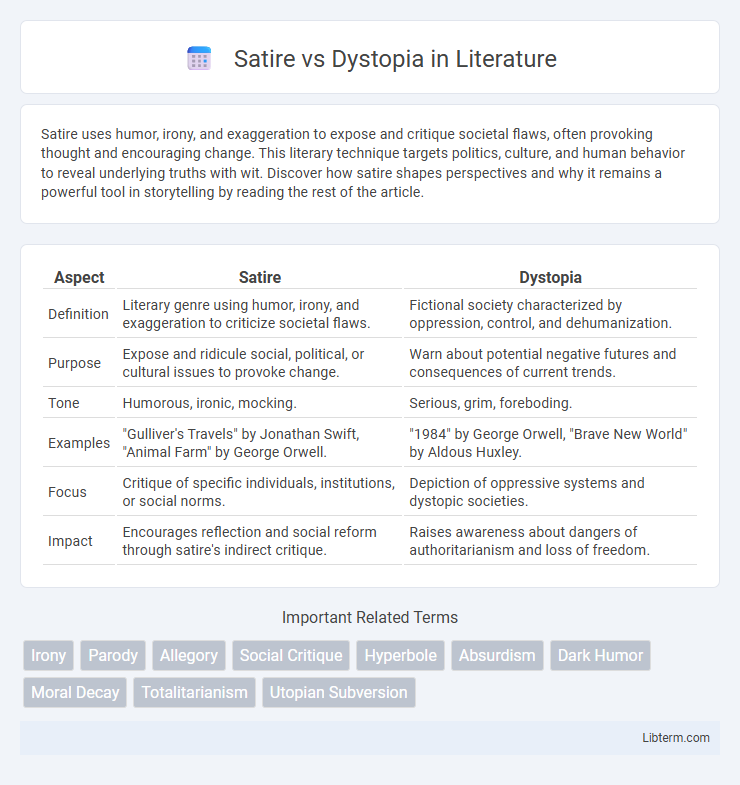Satire uses humor, irony, and exaggeration to expose and critique societal flaws, often provoking thought and encouraging change. This literary technique targets politics, culture, and human behavior to reveal underlying truths with wit. Discover how satire shapes perspectives and why it remains a powerful tool in storytelling by reading the rest of the article.
Table of Comparison
| Aspect | Satire | Dystopia |
|---|---|---|
| Definition | Literary genre using humor, irony, and exaggeration to criticize societal flaws. | Fictional society characterized by oppression, control, and dehumanization. |
| Purpose | Expose and ridicule social, political, or cultural issues to provoke change. | Warn about potential negative futures and consequences of current trends. |
| Tone | Humorous, ironic, mocking. | Serious, grim, foreboding. |
| Examples | "Gulliver's Travels" by Jonathan Swift, "Animal Farm" by George Orwell. | "1984" by George Orwell, "Brave New World" by Aldous Huxley. |
| Focus | Critique of specific individuals, institutions, or social norms. | Depiction of oppressive systems and dystopic societies. |
| Impact | Encourages reflection and social reform through satire's indirect critique. | Raises awareness about dangers of authoritarianism and loss of freedom. |
Understanding Satire: Definition and Purpose
Satire is a literary genre that uses humor, irony, and exaggeration to criticize and expose the flaws or shortcomings of individuals, institutions, or society. Its primary purpose is to provoke thought and encourage social or political change by highlighting absurdities and contradictions. Unlike dystopia, which depicts bleak, oppressive futures, satire often employs wit to reveal truths in a more indirect, engaging manner.
What is Dystopia? Key Characteristics
Dystopia is a fictional society characterized by oppressive social control, environmental degradation, and widespread suffering, often under authoritarian regimes or totalitarian governments. Key characteristics include lack of individual freedom, surveillance, propaganda, and a bleak, controlled environment designed to maintain power and prevent dissent. Frequently depicted in literature and media, dystopian worlds explore themes of dehumanization, loss of autonomy, and societal collapse.
The Roots of Satire and Dystopian Literature
Satire originates from ancient literary traditions, employing humor, irony, and exaggeration to critique social, political, and cultural flaws, as seen in works by Aristophanes and Juvenal. Dystopian literature emerged primarily in the 20th century, rooted in societal anxieties about totalitarianism, technological control, and environmental devastation, exemplified by novels like George Orwell's "1984" and Aldous Huxley's "Brave New World." Both genres share origins in societal critique but diverge in tone and method: satire often uses wit to provoke reflection, while dystopia presents a grim future scenario to warn against current trajectories.
Comparing Satire and Dystopia: Core Differences
Satire uses humor, irony, and exaggeration to criticize societal flaws, often aiming for reform by highlighting absurdities in politics, culture, or human behavior. Dystopia constructs a grim, oppressive world reflecting deeper fears about totalitarianism, loss of freedom, or environmental collapse, provoking reflection through a bleak narrative. While satire targets specific issues with wit, dystopia presents a cautionary, immersive scenario emphasizing systemic failure and despair.
Satirical Techniques in Dystopian Novels
Satirical techniques in dystopian novels employ irony, exaggeration, and parody to critique social, political, or cultural issues by exaggerating flaws within oppressive regimes or flawed societies. These novels often use grotesque or absurd scenarios to highlight the consequences of authoritarianism, censorship, and loss of individual freedoms, exposing the dangers of unchecked power. Authors like George Orwell in "1984" and Aldous Huxley in "Brave New World" use satire to provoke critical reflection on contemporary societal trends through vividly imagined dystopian worlds.
Social Critique: Satire vs. Dystopian Warnings
Satire employs humor and irony to expose societal flaws and provoke critical thinking, often highlighting hypocrisy and absurdity in social, political, or cultural practices. Dystopian narratives present grim, speculative futures to warn against the consequences of current social, technological, or governmental trends, emphasizing oppressive systems and loss of individual freedoms. Both genres serve as powerful tools for social critique, with satire engaging readers through wit and dystopia through cautionary depictions of possible realities.
Classic Works: Iconic Satirical and Dystopian Texts
Classic satirical works such as Jonathan Swift's *Gulliver's Travels* and George Orwell's *Animal Farm* use humor and irony to critique societal flaws and political corruption, while iconic dystopian texts like Orwell's *1984* and Aldous Huxley's *Brave New World* depict oppressive, totalitarian futures to warn against the loss of individuality and freedom. Satire often employs exaggerated characters and scenarios to expose hypocrisy, whereas dystopian literature constructs grim, controlled worlds to illustrate the consequences of unchecked power. Both genres remain influential in literary history for their incisive explorations of human nature and social injustice.
Modern Interpretations: Satire and Dystopia Today
Modern interpretations of satire and dystopia often blend to critique contemporary societal issues through exaggerated, yet plausible, scenarios. Satire employs humor and irony to expose flaws within political and cultural institutions, while dystopia presents grim futures shaped by these flaws, emphasizing the consequences of unchecked power and technological misuse. Works like "Black Mirror" and "The Hunger Games" exemplify this fusion, using speculative settings to reflect on current anxieties about surveillance, authoritarianism, and social inequality.
Effectiveness in Shaping Public Opinion
Satire employs humor and irony to expose societal flaws, making it highly effective in engaging audiences and provoking critical thought about current issues. Dystopian narratives create immersive and often bleak futures that highlight potential consequences of present actions, instilling a sense of urgency and warning. Both genres influence public opinion by encouraging reflection, but satire's immediacy and accessibility often prompt quicker awareness and dialogue.
Satire or Dystopia: Which Resonates More With Readers?
Dystopian literature resonates deeply with readers due to its immersive portrayal of oppressive societies and cautionary futures, tapping into collective anxieties about political, social, and environmental collapse. Satire attracts audiences through sharp wit and humor, exposing societal flaws and human irrationality, often prompting reflection and critique. However, dystopian narratives often create a more lasting emotional impact by allowing readers to experience urgent, high-stakes scenarios that underscore the dangers of current trends taken to extremes.
Satire Infographic

 libterm.com
libterm.com